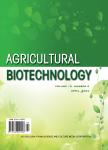Effects of Formaldehyde and Low-light Stress on Growth and Nutrition of Hedera spp.
Effects of Formaldehyde and Low-light Stress on Growth and Nutrition of Hedera spp.作者机构:College of AgricultureKunming University
出 版 物:《Agricultural Biotechnology》 (农业生物技术(英文版))
年 卷 期:2018年第7卷第5期
页 面:48-53,57页
学科分类:090706[农学-园林植物与观赏园艺] 0907[农学-林学] 09[农学]
基 金:Supported by Applied Basic Research Program of Yunnan Province(2017FD087) National Natural Science Foundation of China(31660559)
主 题:Hedera spp. Formaldehyde Weak light Growth Nutrition
摘 要:Potted seedlings of Hedera nepalensis and H. helix were exposed to formaldehyde and low light alone or in combination for four months, before the morphological and nutritive indices of the plants were measured to assess the effects of formaldehyde and low-light stress on the growth and nutrient accumulation of Hedera species. The results showed that treatment with either formaldehyde or low-light stress reduced leaf length, leaf width, stem length, stem diameter, root length and biomass, but increased leaf shape index of the two Hedera species. Treatment with formaldehyde alone increased root-shoot ratio, while treatment with formaldehyde + low light or low light alone decreased root-shoot ratio of the two Hedera species. Under the stress of formaldehyde, soluble sugar content decreased, while starch content increased in roots, stems and leaves of the two Hedera species; total carbon content, proline content and carbon-to-nitrogen (C/N) ratio increased, while protein content and phosphorus content decreased in roots of the two Hedera species; the contents of total carbon, protein and total nitrogen in leaves of the two Hedera species; C/N ratio in roots of H. nepalensis increased; the C/N ratio in roots of H. nepalensis and that in leaves of the two Hedera species significantly increased. Under formaldehyde + low light stress, the soluble sugar content decreased, while starch content increased in stems and leaves of the two Hedera species; starch content in roots of the two Hedera species decreased; the contents of protein and total nitrogen decreased, while C/N ratio increased in leaves of H. nepalensis ; proline content in roots and stems of the two Hedera species significantly increased.



